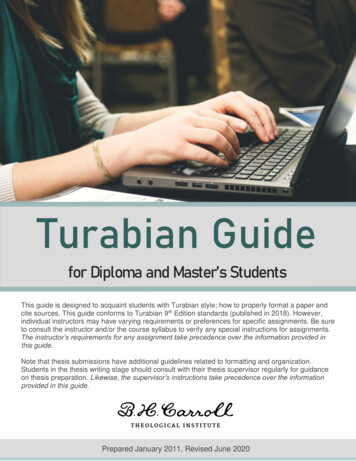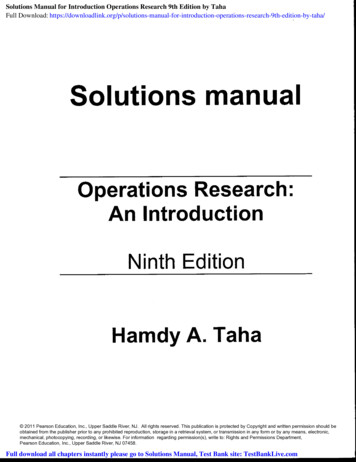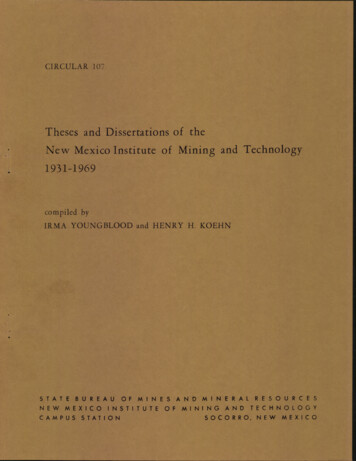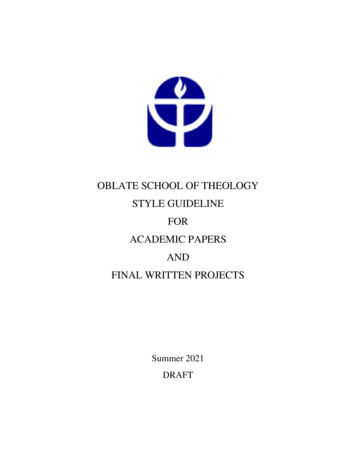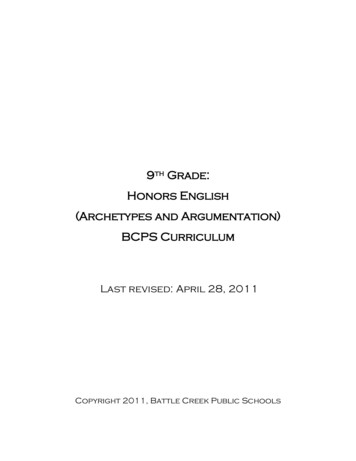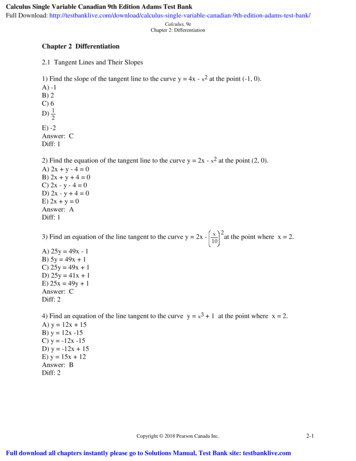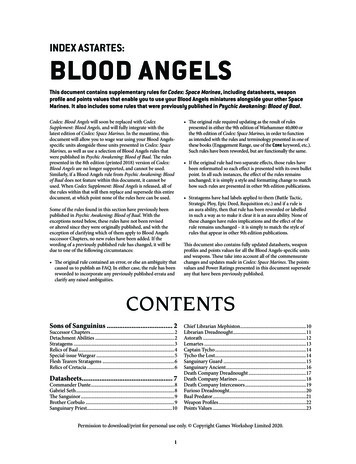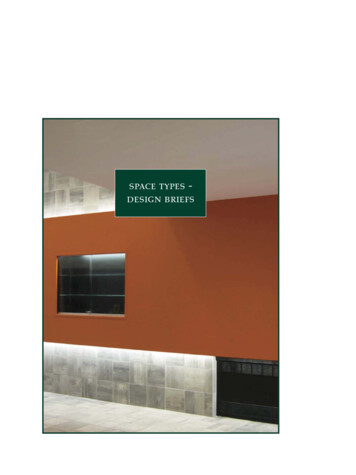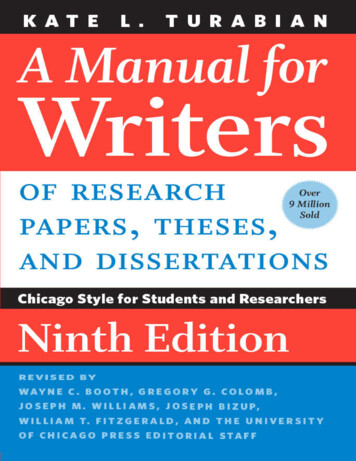
Transcription
A Manual for Writers of Research Papers, Theses, andDissertations9th Edition
Telling About SocietyHoward S. BeckerTricks of the TradeHoward S. BeckerWriting for Social ScientistsHoward S. BeckerThe Craft of ResearchWayne C. Booth, Gregory G. Colomb, Joseph M. Williams, Joseph Bizup,and William T. FitzGeraldThe Chicago Guide to Fact-CheckingBrooke BorelWriting Ethnographic FieldnotesRobert M. Emerson, Rachel I. Fretz, and Linda L. ShawThe Chicago Guide to Grammar, Usage, and PunctuationBryan A. GarnerFrom Dissertation to BookWilliam GermanoFrom Notes to Narrative
Kristen GhodseeThinking Like a Political ScientistChristopher HowardWrite No Matter WhatJoli JensenHow to Write a BA ThesisCharles LipsonThe Writer’s DietHelen SwordStudent’s Guide to Writing College PapersKate L. Turabian
A Manual for Writers of Research Papers, Theses,and DissertationsChicago Style for Students and Researchers9th EditionKate L. TurabianRevised byWayne C. Booth, Gregory G. Colomb, Joseph M. Williams, Joseph Bizup,William T. FitzGerald, and the University of Chicago Press Editorial StaffThe University of Chicago PressChicago and London
Portions of this book have been adapted from The Craft of Research, 4th edition, byWayne C. Booth, Gregory G. Colomb, Joseph M. Williams, Joseph Bizup, andWilliam T. FitzGerald, 1995, 2003, 2008, 2016 by The University of Chicago; andThe Chicago Manual of Style, 17th edition, 2017 by The University of Chicago.The University of Chicago Press, Chicago 60637The University of Chicago Press, Ltd., London 2007, 2013, 2018 by The University of ChicagoAll rights reserved. No part of this book may be used or reproduced in any mannerwhatsoever without written permission, except in the case of brief quotations in criticalarticles and reviews. For more information, contact the University of Chicago Press,1427 E. 60th St., Chicago, IL 60637.Published 2018Printed in the United States of America27 26 25 24 23 22 21 20 19 18 1 2 3 4 5ISBN-13: 978-0-226-49442-5 (cloth)ISBN-13: 978-0-226-43057-7 (paper)ISBN-13: 978-0-226-43060-7 (e-book)DOI: 0001Library of Congress Cataloging-in-Publication DataNames: Turabian, Kate L., author. Booth, Wayne C., editor. Colomb, Gregory G.,editor. Williams, Joseph M., editor. Bizup, Joseph, 1966– editor. FitzGerald,William T., editor.Title: A manual for writers of research papers, theses, and dissertations : Chicago Stylefor students and researchers / Kate L. Turabian ; revised by Wayne C. Booth,Gregory G. Colomb, Joseph M. Williams, Joseph Bizup, William T. FitzGerald, andthe University of Chicago Press editorial staff.Other titles: Chicago guides to writing, editing, and publishing.Description: Ninth edition. Chicago ; London : The University of Chicago Press,2018. Series: Chicago guides to writing, editing, and publishing Includesbibliographical references and index.Identifiers: LCCN 2017047620 ISBN 9780226494425 (cloth : alk. paper) ISBN9780226430577 (pbk. : alk. paper) ISBN 9780226430607 (e-book)Subjects: LCSH: Dissertations, Academic—Handbooks, manuals, etc. Academicwriting—Handbooks, manuals, etc.
Classification: LCC LB2369 .T8 2018 DDC 808.06/6378—dc23LC record available at https://lccn.loc.gov/2017047620This paper meets the requirements of ANSI/NISO Z39.48-1992 (Permanence ofPaper).
ContentsA Note to StudentsPrefacePart I Research and WritingWayne C. Booth, Gregory G. Colomb, Joseph M. Williams, Joseph Bizup, andWilliam T. FitzGeraldOverview of Part I1 What Research Is and How Researchers Think about It1.1 What Research Is1.2 How Researchers Think about Their Aims1.3 Conversing with Your Readers2 Defining a Project: Topic, Question, Problem, WorkingHypothesis2.12.22.32.42.5Find a Question in Your TopicUnderstanding Research ProblemsPropose a Working HypothesisBuild a Storyboard to Plan and Guide Your WorkJoin or Organize a Writing Group3 Finding Useful Sources3.1 Three Kinds of Sources and Their Uses3.2 Search for Sources Systematically3.3 Evaluate Sources for Relevance and Reliability
3.4 Look beyond the Usual Kinds of References3.5 Record Your Sources Fully, Accurately, and Appropriately4 Engaging Your Sources4.14.24.34.44.5Read Generously to Understand, Then Critically to EngageTake Notes SystematicallyTake Useful NotesReview Your ProgressManage Moments of Normal Anxiety5 Constructing Your Argument5.1 What a Research Argument Is and Is Not5.2 Build Your Argument around Answers to Readers’ Questions5.3 Turn Your Working Hypothesis into a Claim5.4 Assemble the Elements of Your Argument5.5 Prefer Arguments Based on Evidence to Arguments Based onWarrants5.6 Assemble an Argument6 Planning a First Draft6.1 Avoid Unhelpful Plans6.2 Create a Plan That Meets Your Readers’ Needs6.3 File Away Leftovers7 Drafting Your Paper7.17.27.37.47.5Draft in the Way That Feels Most ComfortableDevelop Effective Writing HabitsKeep Yourself on Track through Headings and Key TermsQuote, Paraphrase, and Summarize AppropriatelyIntegrate Quotations into Your Text
7.6 Use Footnotes and Endnotes Judiciously7.7 Show How Complex or Detailed Evidence Is Relevant7.8 Be Open to Surprises7.9 Guard against Inadvertent Plagiarism7.10 Guard against Inappropriate Assistance7.11 Work Through Chronic Procrastination and Writer’s Block8 Presenting Evidence in Tables and Figures8.18.28.38.4Choose Verbal or Visual Representations of Your DataChoose the Most Effective GraphicDesign Tables and FiguresCommunicate Data Ethically9 Revising Your Draft9.19.29.39.49.5Check for Blind Spots in Your ArgumentCheck Your Introduction, Conclusion, and ClaimMake Sure the Body of Your Report Is CoherentCheck Your ParagraphsLet Your Draft Cool, Then Paraphrase It10 Writing Your Final Introduction and Conclusion10.1 Draft Your Final Introduction10.2 Draft Your Final Conclusion10.3 Write Your Title Last11 Revising Sentences11.111.211.311.4Focus on the First Seven or Eight Words of a SentenceDiagnose What You ReadChoose the Right WordPolish It Up
11.5 Give It Up and Turn It In12 Learning from Comments on Your Paper12.1 Two Kinds of Feedback: Advice and Data12.2 Find General Principles in Specific Comments12.3 Talk with Your Reader13 Presenting Research in Alternative Forums13.113.213.313.4Plan Your Oral PresentationDesign Your Presentation to Be Listened ToPlan Your Poster PresentationPlan Your Conference Proposal14 On the Spirit of ResearchPart II Source Citation15 General Introduction to Citation Practices15.115.215.315.415.515.6Reasons for Citing Your SourcesThe Requirements of CitationTwo Citation StylesElectronic SourcesPreparation of CitationsCitation Management Tools16 Notes-Bibliography Style: The Basic Form16.116.216.316.4Basic PatternsBibliographiesNotesShort Forms for Notes
17 Notes-Bibliography Style: Citing Specific Types of Sources17.1 Books17.2 Journal Articles17.3 Magazine Articles17.4 Newspaper Articles17.5 Websites, Blogs, and Social Media17.6 Interviews and Personal Communications17.7 Papers, Lectures, and Manuscript Collections17.8 Older Works and Sacred Works17.9 Reference Works and Secondary Citations17.10 Sources in the Visual and Performing Arts17.11 Public Documents18 Author-Date Style: The Basic Form18.1 Basic Patterns18.2 Reference Lists18.3 Parenthetical Citations19 Author-Date Style: Citing Specific Types of Sources19.1 Books19.2 Journal Articles19.3 Magazine Articles19.4 Newspaper Articles19.5 Websites, Blogs, and Social Media19.6 Interviews and Personal Communications19.7 Papers, Lectures, and Manuscript Collections19.8 Older Works and Sacred Works19.9 Reference Works and Secondary Citations19.10 Sources in the Visual and Performing Arts19.11 Public Documents
Part III Style20 s and Words Formed with PrefixesLine Breaks21 Punctuation21.1 Periods21.2 Commas21.3 Semicolons21.4 Colons21.5 Question Marks21.6 Exclamation Points21.7 Hyphens and Dashes21.8 Parentheses and Brackets21.9 Slashes21.10 Quotation Marks21.11 Apostrophes21.12 Multiple Punctuation Marks22 Names, Special Terms, and Titles of Works22.1 Names22.2 Special Terms22.3 Titles of Works23 Numbers23.1 Words or Numerals?23.2 Plurals and Punctuation
23.3 Date Systems23.4 Numbers Used outside the Text24 Abbreviations24.124.224.324.424.524.624.7General PrinciplesNames and TitlesGeographical TermsTime and DatesUnits of MeasureThe Bible and Other Sacred WorksAbbreviations in Citations and Other Scholarly Contexts25 Quotations25.1 Quoting Accurately and Avoiding Plagiarism25.2 Incorporating Quotations into Your Text25.3 Modifying Quotations26 Tables and Figures26.1 General Issues26.2 Tables26.3 FiguresAppendix: Paper Format and SubmissionA.1 General Format RequirementsA.2 Format Requirements for Specific ElementsA.3 File Preparation and Submission RequirementsBibliographyAuthorsIndex
A Note to StudentsKnown by many as simply “Turabian” in honor of its original author, AManual for Writers of Research Papers, Theses, and Dissertations is theauthoritative student resource on “Chicago style.” This book has helpedgenerations of students successfully research, write, and submit papers invirtually all academic disciplines. Its guidelines for source citations andstyle have been condensed and adapted for student writers from another,more comprehensive reference work, The Chicago Manual of Style.Part 1 covers every step of the research and writing process. It providespractical advice to help you formulate the right questions, read critically,and build arguments. It also shows you how to draft and revise your papersto strengthen both your arguments and your writing.Part 2 offers a comprehensive guide to the two methods of Chicago-stylesource citation, beginning with helpful information on general citationpractices in chapter 15. In the humanities and most social sciences, you willlikely use the notes-bibliography style detailed in chapters 16 and 17; in thenatural and physical sciences and some social sciences, you will more likelyuse the author-date style described in chapters 18 and 19.Part 3 covers Chicago’s recommended editorial style, which will helpyou bring consistency to your writing in matters such as punctuation,capitalization, and abbreviations; this section also includes guidance onincorporating quotations into your writing and on properly presenting tablesand figures.The appendix presents formatting and submission requirements for thesesand dissertations that many academic institutions use as a model, but besure to follow any local guidelines provided by your institution.
PrefaceStudents writing research papers, theses, and dissertations in today’scolleges and universities inhabit a world filled with digital technologies thatwere unimagined in 1937—the year dissertation secretary Kate L. Turabianfirst assembled a booklet of guidelines for student writers at the Universityof Chicago. The availability of word-processing software and new digitalsources has changed the way students conduct research and write up theresults. But these technologies have not altered the basic task of the studentwriter: doing well-designed research and presenting it clearly andaccurately while following accepted academic standards for citation, style,and format.Turabian’s 1937 booklet reflected guidelines found in an already classicresource for writers and editors published by the University of ChicagoPress that would ultimately be known as The Chicago Manual of Style(CMOS). The Press began distributing Turabian’s booklet in 1947 and firstpublished the work in book form in 1955, under the title A Manual forWriters of Term Papers, Theses, and Dissertations. Over time, Turabian’sbook has become a standard reference for students of all levels atuniversities and colleges across the country. Turabian died in 1987 at ageninety-four, a few months after publication of the book’s fifth edition.Beginning with that edition, members of the Press editorial staff havecarried out the revisions to the chapters on source citation, style, and paperformat. For the seventh edition (2007), Wayne C. Booth, Gregory G.Colomb, and Joseph M. Williams expanded the focus of the book by addingextensive new material adapted from their book The Craft of Research, alsopublished by the University of Chicago Press and now in its fourth edition(2016). Among the new topics covered in their chapters were the nature ofresearch, finding and engaging sources, taking notes, developing anargument, drafting and revising, and presenting evidence in tables andfigures. Following the deaths of this remarkable trio of authors, whose
collective voice will always animate this work, Joseph Bizup and WilliamT. FitzGerald have with this edition assumed the mantle of revising theirchapters for a new generation of students, as they had previously for TheCraft of Research.Part 1, now aligned with the most recent edition of that book,incorporates updated advice for writers and responds to recentdevelopments in information literacy, including the use of digital materials.Part 2 offers a comprehensive guide to the two Chicago styles of sourcecitation—the notes-bibliography format used widely in the humanities andmost social sciences and the author-date format favored in many of thesciences and some social sciences. Thoroughly updated guidance related toonline citation practices has been supplemented throughout by newexamples featuring the types of sources students are most likely to consult.Part 3 addresses matters of spelling, punctuation, abbreviation, andtreatment of numbers, names, special terms, and titles of works. The finaltwo chapters in this section treat the mechanics of using quotations andgraphics (tables and figures), topics that are discussed from a rhetoricalperspective in part 1. Both parts 2 and 3 have been updated for this editionin accordance with the seventeenth edition (2017) of The Chicago Manualof Style. The recommendations in this manual in some instances divergefrom CMOS in small ways, to better suit the requirements of academicpapers as opposed to published works.The appendix presents guidelines for paper format and submission thathave become the primary authority for dissertation offices throughout theUnited States. These guidelines have been updated to reflect the nearlyuniversal electronic submission of papers and to feature new examples fromrecently published dissertations. This appendix is intended primarily forstudents writing PhD dissertations and master’s and undergraduate theses,but the sections on format requirements and electronic file preparation willalso aid those writing class papers. An extensive bibliography, organized bysubject area and fully updated, lists sources for research and style issuesspecific to various disciplines.The guidelines in this manual offer practical solutions to a wide range ofissues encountered by student writers, but they may be supplemented—oreven overruled—by the conventions of specific disciplines or the
preferences of particular institutions, departments, or instructors. All of thechapters on style and format remind students to review the requirements oftheir university, department, or instructor, which take precedence over theguidelines presented in this book.Updating a book that has been used by millions of students over eightyyears is no small task, and many people participated in preparing this ninthedition. The Press staff welcomed Bizup and FitzGerald to their new role inrevising part 1. Russell David Harper, the principal reviser of the sixteenthand seventeenth editions of CMOS, revised parts 2 and 3 and the appendix.Several recent PhD recipients from the University of Chicago allowed theuse of excerpts from their dissertations in the appendix, where they arecredited individually.Within the Press, the project was developed under the guidance of editorsMary E. Laur and David Morrow, editorial director Christie Henry, andeditorial associates Rachel Kelly and Susan Zakin. Lucy Johnson andKristin Zodrow offered additional research support. Ruth Goring edited themanuscript, June Sawyers proofread the pages, and James Curtis preparedthe index. Michael Brehm provided the design, while Joseph Claudesupervised the production. Carol Kasper, Jennifer Ringblom, Lauren Salas,and Carol Fisher Saller brought the final product to market.The University of Chicago Press Editorial Staff
Part IResearch and WritingWayne C. Booth, Gregory G. Colomb, Joseph M. Williams, Joseph Bizup,and William T. FitzGerald
Overview of Part IWe know how daunting it can feel to start a substantial research project,whether it’s a doctoral dissertation, a master’s or senior thesis, or just a longclass paper. But you can handle any project if you break it into its parts,then work on them one step at a time. Part I of this book shows you how.We first discuss the aims of research and what readers will expect of anyresearch paper (a term we use broadly to refer to all varieties of researchbased writing). We then focus on how to find a research question andproblem whose answer is worth your time and your readers’ attention; howto find and use information from sources to back up your answer; and thenhow to plan, draft, and revise your paper so your readers will see that youranswer is based on sound reasoning and reliable evidence.Several themes run through this part. You can’t plunge into a project blindly; you must plan it, then keep thewhole process in mind as you take each step. So think big, but break theprocess down into small goals that you can meet one at a time.Your best research will begin with a question that you want to answer.But you must then imagine readers asking questions of their own: Sowhat if you don’t answer it? Why should I care?From the outset, you should try to write every day, not just to record thecontent of your sources but to clarify what you think of them. You shouldalso write down your own developing ideas to get them out of the cozywarmth of your head and into the cold light of day, where you can see ifthey still make sense. You probably won’t use much of this writing inyour final draft, but it is essential preparation for it.No matter how carefully you do your research, readers will judge it byhow well you present it, so you must know what they will look for in aclearly written paper that earns their respect.
If you’re an advanced researcher, skim chapters 1–4. You will see theremuch that’s familiar; but if you’re also teaching, it may help you explainwhat you know to your students more effectively. Many experiencedresearchers tell us that chapters 5–12 have helped them not only to explainto others how to conduct and report research, but also to draft and revisetheir own writing more quickly and effectively.If you’re just starting your career in research, you’ll find every chapter ofpart 1 useful. Skim it all for an overview of the process; then as you workthrough your project, reread chapters relevant to your immediate task.You may feel that the steps described here are too many to remember, butyou can manage them if you take them one at a time, and as you do moreresearch they’ll become habits of mind. Don’t think, however, that youmust follow these steps in exactly the order we present them. Researchersregularly think ahead to future steps as they work through earlier ones andrevisit earlier steps as they deal with a later one. (That explains why we sooften refer you ahead to anticipate a later stage in the process and back torevisit an earlier one.) And even the most systematic researcher hasunexpected insights that send her off in a new direction. Work from a plan,but be ready to depart from it, even to discard it for a new one.If you’re a very new researcher, you may also think that some matters wediscuss are beyond your immediate needs. We know that a ten-page classpaper differs from a dissertation. But both require a kind of thinking thateven the newest researcher can start practicing. You begin your journeytoward full competence when you not only know what lies ahead but alsocan start practicing the skills that experienced researchers began to learnwhen they were where you are now.No book can prepare you for every aspect of every research project. Andthis one won’t help you with the specific methodologies in fields such aspsychology, economics, and philosophy, much less physics, chemistry, andbiology. Nor does it tell you how to adapt what you learn about academicresearch to business or professional settings.But it does provide an overview of the processes and habits of mind thatunderlie all research, wherever it’s done, and of the plans you must make toassemble a paper, draft it, and revise it. With that knowledge and with help
from your teachers, you’ll come to feel in control of your projects, notintimidated by them, and eventually you’ll learn to manage even the mostcomplex projects on your own, in both the academic and the professionalworlds.The first step in learning the skills of sound research is to understand howexperienced researchers think about its aims.
1 What Research Is and How ResearchersThink about It1.1 What Research Is1.2 How Researchers Think about Their Aims1.3 Conversing with Your ReadersWhenever we read about a scientific breakthrough or a crisis in worldaffairs, we benefit from the research of others, who likewise benefited fromthe research of countless others before them. When we walk into a library,we are surrounded by more than twenty-five centuries of research. Whenwe go on the internet, we can read the work of millions of researchers whohave posed questions beyond number, gathered untold amounts ofinformation from the research of others to answer them, and then sharedtheir answers with the rest of us. We can carry on their work by asking and,we hope, answering new questions in turn. Governments spend billions onresearch, businesses even more. Research goes on in laboratories andlibraries, in jungles and ocean depths, in caves and in outer space, in officesand, in the information age, even in our own homes. Research is in fact theworld’s biggest industry.So what, exactly, is it?
1.1 What Research IsYou already have a basic understanding of research: answering a questionby obtaining information. In this sense, research can be as simple aschoosing a new phone or as complex as discovering the origin of life. Inthis book we use research in a specific way to mean a process of systematicinquiry to answer a question that not only the researcher but also otherswant to solve. Research thus includes the steps involved in presenting orreporting it. To be a true researcher, as we are using the term, you mustshare your findings and conclusions with others.If you are new to research, you may think that your paper will add littleto the world’s knowledge. But done well, it will add a lot to yourknowledge and to your ability to communicate that knowledge. As youlearn to do your own research, you also learn to use and judge that ofothers. In every profession, researchers must read and evaluate the work ofothers before they make a decision. This is a job you will do better after youhave learned how others judge yours.This book focuses on research in the academic world, but every day weread or hear about research that affects our lives. Often we get news ofresearch secondhand, and it can be difficult to know what reasoning andevidence support a claim. But research doesn’t ask for our blind trust or thatwe accept something on the basis of authority. It invites readers to thinkcritically about evidence and reasoning.That is how research-based writing differs from other kinds of persuasivewriting: it must rest on shared facts that readers accept as truthsindependent of your feelings and beliefs. Your readers must be able tofollow your reasoning from evidence they accept to the claim you drawfrom it. Your success as a researcher thus depends not just on how well yougather and analyze data but also on how clearly you report your reasoningso that your readers can test and judge it before making your claims part oftheir knowledge and understanding.
1.2 How Researchers Think about Their AimsAll researchers collect information, what we’re calling data. Butresearchers do not merely gather facts on a topic—stories about the Battleof the Alamo, for example. They look for specific data to test and support ananswer to a question that their topic inspired them to ask, such as Why hasthe Alamo story become a national legend? In doing so, they also imagine acommunity of readers who they believe will share their interest and helpthem test and support an answer to that question.Experienced researchers, however, know that they must do more thanconvince us that their answer is sound. They must also show us why theirquestion was worth asking, how its answer helps us understand some biggerissue in a new way. If we can figure out why the Alamo story has become anational legend, we might then answer a larger question: how haveregional myths shaped the American character?You can judge how closely your thinking tracks that of an experiencedresearcher by describing your project in a sentence like this:1. Topic: I am working on X (stories about the Battle of the Alamo)2. Question: because I want to find out Y (why its story becamea national legend)3. Significance: so that I can help others understand Z (howsuch regional myths have shaped the Americancharacter).That sentence is worth a close look, because it describes not just theprogress of your research but your personal growth as a researcher.1. Topic: “I am working on X . . .”: Those new to research often begin witha simple topic like the Battle of the Alamo. But too often they stop there,with nothing but a broad topic to guide their work. Beginning this way,they may pile up dozens or hundreds of notes but then can’t decide whatdata to keep or discard. When it comes time to write, their papers become“data dumps” that leave readers wondering what all those data add up to.
2. Question: “. . . because I want to find out Y . . .”: More experiencedresearchers begin not just with a topic but with a research question, suchas Why has the story of the Alamo become a national legend? They knowthat readers will think their data add up to something only when theyserve as evidence to support an answer. Indeed, only with a question cana researcher know what information to look for and, once obtained, whatto keep—and not just data that support a particular answer but also datathat test or discredit it. With sufficient evidence to support an answer, aresearcher can respond to data that seem to contradict it. In writing apaper, the researcher tests that answer and invites others to test it too.3. Significance: “. . . so that I can help others understand Z”: The bestresearchers understand that readers want to know not only that an answeris sound but also why the question is worth asking: So what? Why shouldI care why the Alamo story has become a national legend? Think of itthis way: what will be lost if you don’t answer your question? Youranswer might be Nothing. I just want to know. Good enough to start butnot to finish, because eventually your readers will want an answerbeyond Just curious.Answering So what? is tough for all researchers, beginning andexperienced alike, because when you only have a question stemming from atopic of personal interest, it’s hard to predict whether others will find itsanswer significant. Some researchers therefore work backwards: they beginnot by following their own curiosity but by crafting questions withimplications for bigger ones that others in their field already care about. Butmany researchers, including us, find that they cannot address that third stepuntil they finish a first draft. So it’s fine to begin your research withoutbeing able to answer So what?, and if you are a student, your teacher mayeven let you skip that last step. But if you are doing advanced research, youmust take it, because your answer to So what? is what makes your researchmatter to others.In short, not all questions are equally good. We might ask how many catsslept in the Alamo the night before the battle, but so what if we find out? Itis hard to see how an answer would help us think about any larger issue
worth understanding, so it’s a question that’s probably not worth asking(though as we’ll see, we could be wrong about that).How good a question is depends on its significance to some communityof readers. Exactly what community depends on your field but also on howyou frame your research. You can try to expand your potential readership byconnecting Z to even broader questions: And if we can understand what hasshaped the American character, we might understand better who Americansthink they are. And when we know that, we might better understand whyothers in the world judge them as they do. Now perhaps political scientistswill be as interested in this research as historians. On the other hand, if youtry to widen your audience too much, you risk losing it altogether.Sometimes it’s better to address a smaller community of specialists.We can’t tell you the right choice, but we can tell you two wrong ones:trying to interest everyone (some people just won’t care no matter how youframe your research) or not trying to interest anyone at all.
1.3 Conversing with Your ReadersWhen you can explain the significance of your research, you enter into akind of conversation with your research community. Some people, whenthey think of research, imagine a lone scholar or scientist in a hushedlibrary or lab. But no places are more crowded with the presence of othersthan these. When you read a book or an article or a report, you silentlyconverse with its authors—and through them with everyone else they haveread. In fact, every time you go to a written source for information, you joina conversation between writers and readers that began millennia ago. Andwhen you report your
The Craft of Research Wayne C. Booth, Gregory G. Colomb, Joseph M. Williams, Joseph Bizup, and William T. FitzGerald The Chicago Guide to Fact-Checking Brooke Borel Writing Ethnographic Fieldnotes Robert M. Emerson, Rachel I. Fretz, and Linda L. Shaw The Chicago Guide to Grammar, Usage,
